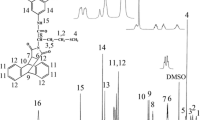Abstract
An aromatic chiral diacid monomer, 5-[4-(2-phthalimidiylpropanoylamino)-benzoylamino]isophthalic acid was synthesized in five steps under conventional heating in high yield and purity. A series of soluble, thermally stable and optically active polyamides (PA)s containing pendent groups made of phthalimide, flexible l-alanine and benzamide sequence have been successfully synthesized under microwave irradiation. Excellent yields and very short reaction time were the main characteristics of this method. The same polymerization reactions were also carried out by conventional thermal heating and the results are compared. The resulting PAs had inherent viscosity in the range of 0.50–0.79 dL g−1. All of the these polymers are readily dissolved in various solvents such as N-methyl-2-pyrrolidinone, N,N-dimethylacetamide and N,N-dimethylformamide and showed glass-transition temperature above 200°C. Thermogravimetric analysis demonstrated that the 10% weight-loss temperatures in nitrogen were 372 and 422°C for selected two PAs. All of these polymers showed optical rotation which is due to successful insertion of l-alanine in the structure of chiral diacid monomer.





Similar content being viewed by others
References
Akekah A, Sherrington DC (1981) Application of functionalized polymers in organic synthesis. Chem Rev 81:557–587
Bose AK, Greer F, Price CC (1958) Procedure for phthaloylation under mild conditions. J Org Chem 23:1335–1338
Cassidy PE (1980) Thermally stable polymers. Marcel Dekker, New York
Ferrero E, Espeso JF, Campa JG, Abajo JD, Lozano AE (2002) Synthesis and characterization of aromatic polyamides containing alkylphthalimido pendent groups. J Polym Sci Part A Polym Chem 40:3711–3721
Ge Z, Yang S, Tao Z, Liu J, Fan L (2004) Synthesis and characterization of novel soluble fluorinated aromatic polyamides derived from fluorinated isophthaloyl dichlorides and aromatic diamines. Polymer 45:3627–3635
Hsiao SH, Chen CW, Liou GS (2004) Novel aromatic polyamides bearing pendent diphenylamino or carbazolyl groups. J Polym Sci Part A Polym Chem 42:3302–3313
Iannelli M, Ritter H (2005) Microwave-assisted direct synthesis and polymerization of chiral acrylamide. Macromol Chem Phys 206:349–353
Kappe CO (2004) Controlled microwave heating in modern organic synthesis. Angew Chem Int Ed Eng 43:6250–6284
Liou GS, Yen HJ, Su YT, Lin HY (2007) Synthesis and properties of wholly aromatic polymers bearing cardo fluorene moieties. J Polym Sci Part A Polym Chem 45:4352–4363
Liaw DJ, Hsu PN, Chen JJ, Liaw BY, Hwang CY (2001) Synthesis and characterization of new soluble polyamides containing phthalimide pendent group. J Polym Sci Part A Polym Chem 39:1557–1563
Loupy A (2006) Microwaves in organic synthesis, 2nd edn. Wiley, New York
Mallakpour S, Kolahdoozan M (2008) Synthesis and properties of novel soluble aromatic polyamides derived from 5-(2-phthalimidyl-3-methylbutanoylamino)isophthalic acid and aromatic diamines. React Funct Polym 68:91–96
Mallakpour S, Rafiee Z (2007) Efficient combination of ionic liquids and microwave irradiation as a green protocol for polycondensation of 4-(3-hydroxynaphthalene)-1, 2, 4-triazolidine-3, 5-dione with diisocyanates. Polymer 48:5530–5540
Mallakpour S, Rafiee Z (2008a) Use of ionic liquid and microwave irradiation as a convenient, rapid and eco-friendly method for synthesis of novel optically active and thermally stable aromatic polyamides containing N-phthaloyl-l-alanine pendent group. Polym Degrad Stab 93:753–759
Mallakpour S, Rafiee Z (2008b) Safe and fast polyamidation of 5-[4-(2-phthalimidiylpropanoylamino)benzoylamino]isophthalic acid with aromatic diamines in ionic liquid under microwave irradiation. Polymer 49:3007–3013
Mallakpour S, Seyedjamali H (2008) Synthesis and characterization of novel organosoluble and optically active aromatic polyesters containing l-methionine and phthalimide pendent groups. Amino Acids 34:531–538
Mallakpour S, Rafiemanzelat F (2006) Study of the miscibility of hard and soft segments of optically active poly(amide-imide-ether-urethane) copolymers based-l-leucine with different soft segments. Polym Bull 56:9–18
Mallakpour S, Taghavi M (2008) A facile, microwave-assisted synthesis of novel optically active polyamides derived from 5-(3-methyl-2-phthalimidylpentanoylamino)isophthalic acid and different diisocyanates. Eur Polym J 44:87–97
Noyori K, Kitamura M (1991) Enantioselective addition of organometallic reagents to carbonyl compounds: chirality transfer, multiplication, and amplification. Angew Chem Int Ed Eng 30:49–69
Okamoto Y, Nakano T (1994) Asymmetric polymerization. Chem Rev 94:349–372
Okamoto Y, Yashima E (1998) Polysaccharide derivatives for chromatographic separation of enantiomers. Angew Chem Int Ed Eng 37:1020–1043
Pu L, Yu II-B (2001) Catalytic asymmetric organozinc additions to carbonyl compounds. Chem Rev 101:757–824
Sinnwell S, Ritter H (2006) Microwave accelerated polymerization of 2-phenyl-5, 6-dihydro-4h-1,3-oxazine: kinetics and influence of end-groups on glass transition temperature. Macromol Rapid Commun 27:1335–1340
Soai K, Niwa S (1992) Enantloselective addition of organozinc reagents to aldehydes. Chem Rev 92:833–856
Wulff G (1989) Main-chain chirality and optical activity in polymers consisting of C–C chains. Angew Chem Int Ed Eng 28:21–37
Yang HH (1989) Aromatic high-strength fibers. Wiley, New York, pp 66–289
Yuki H, Okamoto Y, Okamoto I (1980) Resolution of racemic compounds by optically active poly(triphenylmethyl methacrylate). J Am Chem Soc 102(20):6356–6358
Zhang C, Liao L, Gong S (2007) Recent developments in microwave-assisted polymerization with a focus on ring-opening polymerization. Green Chem 9:303–314
Acknowledgments
We wish to express our gratitude to the Research Affairs Division Isfahan University of Technology (IUT) for financial support. Further financial support from National Elite Foundation (NEF) and Center of Excellency in Sensors and Green Research (IUT) are also gratefully acknowledged.
Author information
Authors and Affiliations
Corresponding author
Rights and permissions
About this article
Cite this article
Mallakpour, S., Rafiee, Z. Microwave-induced synthesis of new optically active and soluble polyamides containing pendent 4-(2-phthalimidiylpropanoylamino)benzoylamino-groups. Amino Acids 37, 665–672 (2009). https://doi.org/10.1007/s00726-008-0186-7
Received:
Accepted:
Published:
Issue Date:
DOI: https://doi.org/10.1007/s00726-008-0186-7



